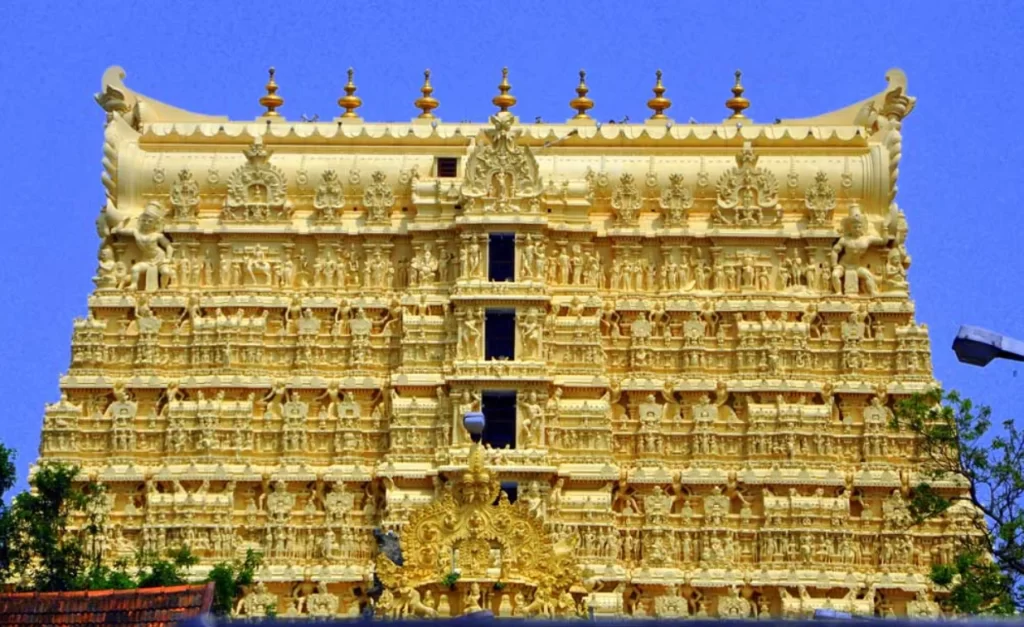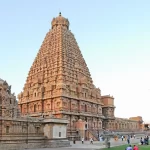Padmanabha Temple -Travancore, often known as Thiruvananthapuram or Trivandrum, is presently the capital of Kerala. Trivandrum, formerly known as Ananthasayanam, was named after Lord Vishnu and has various traditions surrounding its foundation.
It is thought that the genesis of Trivandrum is linked to the origin of the Padmanabhaswamy Temple. One of the tales linked with it is that of a woman who discovered a newborn boy in Anantha Kadu (the current location of the temple, which was once a forest).
She fed the wailing infant and then left him in the shade of a tree. When she returned, she saw a five-headed snake guarding the infant from the sun.
The infant, said to be an avatar of Lord Vishnu, was then served milk and Kanji (rice soup) in a coconut shell. When the then-Maharaja learned about the tragedy, he ordered that a temple be built at the site.
Vilwamangalam Swamiyar and Padmanabha Temple
Another version of the story is about Vilwamangalam Swamiyar, a saint who is credited for consecrating most Malabar temples. He used to pray to the Salagramams (holy stones believed to be avatars of Vishnu) every day and close his eyes in concentration towards Mahavishnu, hoping to see him one day. Every day, a youngster interrupted his prayers.
Until one day, out of wrath, he grabbed the infant while his eyes remained closed. Before the Saint could open his eyes, the youngster revealed his actual identity as Mahavishnu and stated that he would only appear in the Anantha Kadu (forest).
Having never heard of Anantha Kadu, he began jogging in the direction of this jungle. He frequently heard the tinkling of a child’s waist ornament and continued to pursue it.
Vilwamangalam Swamiyar finally arrived at a location where he could hear a baby scream. He witnessed a woman threatening the infant that if he continued to scream, she would toss him into the Anantha Kadu.
The saint requested the lady to take him to the Kadu. There, he continued exploring the region until he came to a massive Mahua (Madhuca Longifolia) tree. Suddenly, the massive tree toppled.
Swamiyar observed Lord Vishnu sleeping atop Adishesha, the King of Nagas, which stretched from Tiruvallam to Tiruappapur. When the Saint saw this, he begged to the god to shrink so that he might give sacrifices and do circumambulations around him.
Padmanabha Temple
The deity heard his petition. It is said that the fallen tree was utilized to chisel the picture of the god within the Padmanabhaswamy Temple. The then-Maharaja of Travancore ordered the construction of a shrine over this figure. This gave rise to the well-known Sri Padmanabhaswamy Kshetram at Tiruvananthapuram.
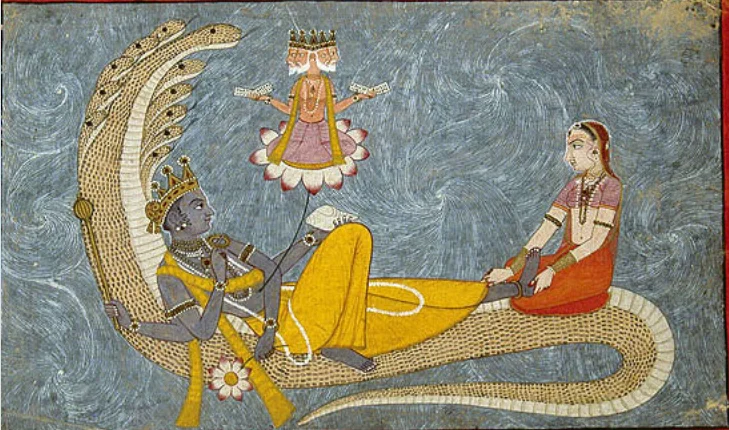
The Sri Padmanabhaswamy Temple is unusual in that it is the only major temple complex in Kerala that combines Dravidian architectural styles with indigenous Kerala architectural characteristics.
It is one of the most well-known Vaishnava Shrines in South India, and it is one of the few temples where Lord Vishnu is shown reclining on Adishesha, with Brahma, the creator, seated on a lotus stemming from Lord Vishnu’s navel.
The Gopuram, or doorway, of this temple is remarkably similar to the Dravidian style temples commonly seen in Tamil Nadu. No other important temple in Kerala has such an ornate gopuram.
The Royal Family of Travancore considers Sri Padmanabhaswamy to be their primary god. They were also the most devoted followers of the Lord. This dates back to Maharaja Marthanda Varma’s reign, when he made a historic decision that impacted the lives of the Royal Family members.
Marthanda Varma
Marthanda Varma, who assumed the royal throne in 1729, is regarded as one of the region’s finest monarchs. He often known as the “Maker of Modern Travancore,” reinforced defenses, maintained disciplined troops educated by a Flemish commander, acquired neighboring lands, and, most significantly, took an active interest in the upkeep of the Padmanabha Temple.
During his rule, the existing building was expanded with a few additions. He also reconsecrated the idol of Lord Padmanabhasawmy, inserting twelve thousand Salagramams.
In December 1749, he made the significant decision to dedicate his realm to Sri Padmanabha and adopted the title Padmanabha Temple Dasa (Servant of the Lord).
Since that day, Travancore has belonged to the Lord rather than any individual or the Royal Family. Marthanda Varma’s final words to his nephew, Rama Varma, were: “No deviation whatever should be made in regard to the dedication of the Kingdom to Sri Padmanabhaswamy, and all additional territorial advances should be made over to the Devasom.”
Marthanda Varma’s sister’s son, Rama Varma, followed him, distinguishing the Royal Family of Travancore from other Royal Families.
Muramakkathayam or the Matrilineal system
Travancore’s Royal Family followed the Muramakkathayam, or matrilineal system. In this arrangement, the women of the family had greater influence than the males, and they were responsible for delivering an heir to the Royal Family.
The Maharaja’s nephew (his sister’s son) was always the heir apparent to the throne. Also, the Maharaja’s sister, not his wife, gained the title of Maharani. This meant that if the Maharani died, leaving only boys, there would be no heir to the crown.
As a result, there have been instances in which the family lacked a female successor. In such instances, they frequently adopted female children who could fill this role. Adoption has always been a part of the Travancore Family.
Interestingly, Marthanda Varma was the son of a Princess who was adopted by the family. Adoption was done from the Kolathiri family, who were also well-known.
Young females were adopted into the Royal Family and would become the Rani of Attingal. Attingal was commonly referred to be a Queendom since it was controlled by the Ranis of the Royal Family.
It did not come under the direct jurisdiction of the Maharaja of Travancore until the reign of Marthanda Varma, who ‘merged Travancore with Attingal.’
In the fifth century, two princesses were adopted into the Venad family (from which the Royal Family of Travancore descended) and granted permission to use the earnings generated by certain estates near Attingal. since then, the Ranis of the Royal Family have been referred to as the Ranis of Attingal.
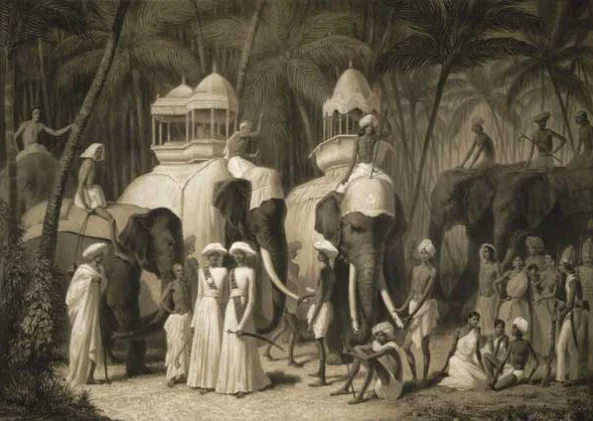
Maharani Lakshmi Bayi and Maharani Parvati Bayi
Adoptions of this type occurred in 1857 and 1900, as examples. In 1857, two daughters were adopted by the Royal Family. Maharani Lakshmi Bayi, the Senior Rani, and Maharani Parvati Bayi, the Junior Rani, were the roles assigned to these daughters in the household.
A few years later, the Senior Rani passed away without leaving a successor, but the Junior Rani left behind three sons: Kerala, Rama, and Marthanda Varma. Once more, this placed the family in a position where adoption was their only choice.
Maharani Lakshmi Bayi, the Senior Rani, under pressure to carry on the family line and find young girls for adoption. As a result, the family adopted two daughters once again in 1900, calling them Senior Rani (Maharani Sethu Lakshmi Bayi) and Junior Rani (Maharani Sethu Parvati Bayi).
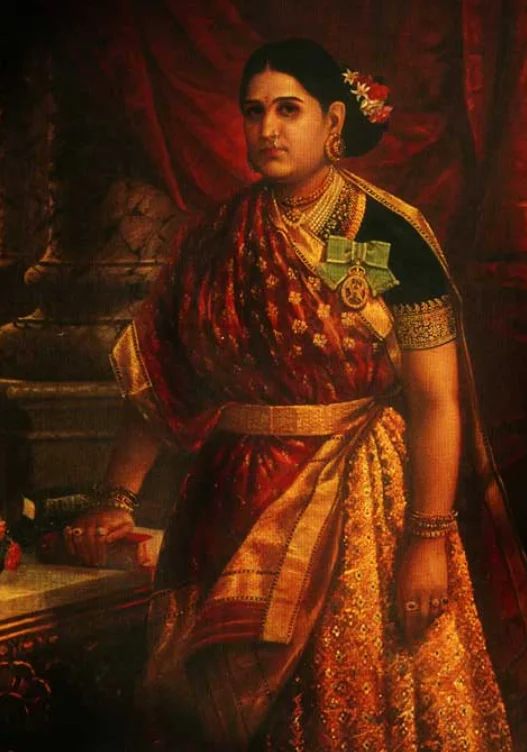
Regretfully, the family had a difficult period in 1901 under Mulam Thirunal’s rule, which nearly led to the circumstance where there would be no male heir to the throne in the future.
ALSO READ: Durga Puja | रहस्यमयी चमत्कार: दुर्गा पूजा का समारोह
Death of Elaya Raja Chathyam Thirunal
It all began in October 1900 with the unexpected death of the first prince, Aswathi Thirunal, and the death of the heir apparent to the throne, Elaya Raja Chathyam Thirunal. On June 15, 1901, the death of Maharani Lakshmi Bayi, the Senior Rani, made matters worse.
The succession situation in the Travancore state at the time is explained in a letter from the Chief Secretary to the Government, who is stationed in Fort St. George to the Secretary for the Govt. of India.
Due to a succession of fatalities in the family, there was no male heir apparent to inherit the Royal Seat in the event that the ruling Maharaja, Maharaja Mulam Thirunal, also passed away too soon.
First, because the Junior and Senior Rani, who were just adopted into the Royal Family, were only three and four years old, respectively, they were unable to produce an heir in the near future.
Secondly, in the event that any of them produced a male successor. That heir could not have assumed the title of Maharaja until he was eighteen. There would be no male successor until 1930 under such a scenario.
Luckily, Maharaja Mulam Thirunal held power for 39 years, till 1924. The Senior Rani, Maharani Sethu Lakshmi Bayi, held the position of regent until 1931. When the heir Chitra Thirunal became eighteen and qualified to ascend to the throne.
The greatest devotees of Padmanabha Temple
The Travancore Royal Family remained the staunchest followers of Lord Padmanabha Temple. They oversaw the operation of the Padmanabhaswamy temple because he was the primary god of the Royal Family.
The State of Kerala was acknowledged as the temple’s custodian in 1971 when the constitution was amended. Changing the previous belief that the Ruler of Travancore was the temple’s custodian.
Many people think that the Royal Family gave the Lord significant gifts of money and priceless stones. Which are now stored in the temple’s underground vaults.
The vast sums of money that were recently found in the Temple are well known around the world. Who is the rightful owner of this treasure is still up for dispute.
